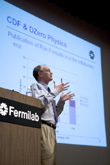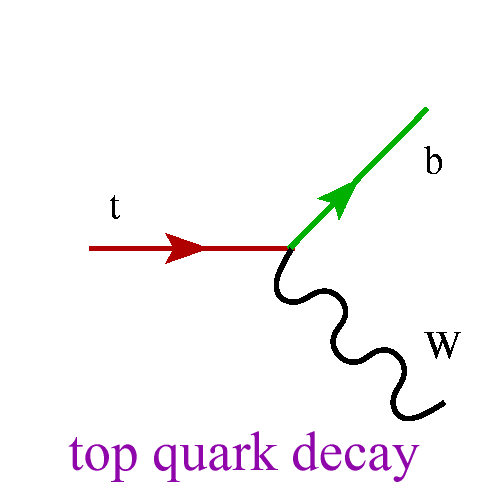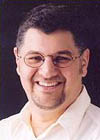 | Thursday, June 9, 2005 |
|
Thursday, June 9 9:00 a.m. Users' Annual Meeting - Auditorium THERE WILL BE NO THEORETICAL PHYSICIS SEMINAR THIS WEEK THERE WILL BE NO DIRECTOR'S COFFEE BREAK TODAY 4:00 p.m. Accelerator Physics and Technology Seminar - 1 West Speaker: J. Wei, Brookhaven National Laboratory Title: The SNS Ring: Design, R&D and Construction 5:30 p.m. Graduate Student Association New Perspectives Poster Session - Wilson Hall Atrium
Friday, June 10
Saturday, June 11 |
|
Extended Forecast |
Secon Level 3 |
|
Thursday, June 9 Tomato Florentine Grilled Chicken Cordon Bleu Sandwich $4.85 Chimichangas $3.75 Chicken Marsala $3.75 Maryland Crab Salad $4.85 Italian Sausage Calzones $3.50 SW Chicken Salad with Roasted Corn Salsa $4.85 The Wilson Hall Cafe now accepts Visa, Master Card, Discover and American Express at Cash Register #1.
Wilson Hall Cafe Menu |
| Fermilab Today is online at: http://www.fnal.gov/today/ Send comments and suggestions to today@fnal.gov Fermilab Today archive Fermilab Today PDF Version Fermilab Result of the Week archive Fermilab Safety Tip of the Week archive Linear Collider News archive Fermilab Today classifieds Subscribe/Unsubscribe to |
|
Planning is Your Priority,
OSTP's Looney Tells Users Patrick Looney, Assistant Director for Physical Science and Engineering in the Office of Science and Technology Policy, advised Fermilab users on Wednesday morning that advancing the science of matter, space and time requires a keen
Looney said building the proposed International Linear Collider "is not impossible-not easy, but not impossible." And from the vantage point of a policy advisory body operating out of the Executive Office of the President, he outlined the political realities of Washington that would be involved in making the machine a reality. "In DC, if you get 'No' as an answer, you're out of luck," Looney told the full house in Ramsey Auditorium, opening the Users Annual Meeting. "If you say, 'Can we have several billion dollars to build this machine?' you will get a 'No.' You want to try to ask a question that will not get a 'No,' such as, 'Can we keep this path going?' Then you need to make the decisions one at a time, and not try to make them all at once." He used the ITER fusion reactor project as an illustration of step-by-step decision-making, while admitting that ITER was hardly a paradigm: "The one thing ITER did right," Looney said, "was to make a
Ironically, ITER also figured in Looney's assertion on the need for international consensus on US responsibility to take its "turn" in building a big machine. He said the US was pressed from the highest levels of other governments, by Prime Ministers and presidents, to rejoin ITER. "We need to have other countries press the US to step up to the plate," Looney said.
|
|
GDE: Director's Corner from Barry Barish | ||
| ||
|
This is our new GDE communications web page, which we have installed on the Interactions.org Linear Collider Communication website. It represents what will become an important tool for us to inform each other and the community what is going on with the GDE. I plan to write a regular short article, "The Director’s Corner," to share my personalized views of the accomplishments, developments and plans, as we work through the steps of creating the global design for the ILC.
This interim web page will be published weekly and will then migrate to and evolve into a regular part of the ILC GDE website, which we are creating. We are working hard to develop our own operational GDE website in time for the Snowmass ILC Workshop. We plan to make it the working website for the meeting. We are putting considerable effort into designing what will be an informative and functional website for the GDE. This is essential for the functioning of such a widely dispersed collaboration. To design the website, we have contracted with Xeno Media, who recently created the new Fermilab and SLAC websites, and we are involving many persons representing different parts of our ILC community in reviewing their work and progress, to ensure that we will have the features and functionality we will need. A well-designed functional website will go a long way toward helping to bridge the great distances separating those of us that need to work closely together on a daily basis to develop the ILC design.
|
|
From Lamar News, June 8, 2005 Auger chooses SE Colorado by Virgil Cochran The Pierre Auger Collaboration today officially named Southeastern Colorado as the site for a cosmic ray observatory that will cover portions of at least three counties.
Pablo Bauleo, a postdoctoral researcher at Colorado State University, a top scientist in the project, said the full Auger Collaboration unanimously adopted a resolution naming the Colorado site as the Northern Hemisphere site during its meeting in Orsay, France. The resolution recommends Utah as a backup northern site and recommends continued contact with a third potential backup site in Idaho.
|
Lonely Top Quarks
| ||||
| ||||
|
The DZero experiment has recently completed a search for single top quark production with a large sample of data. The analysis maximizes the acceptance for single top quark events at every step. Separation of the single top quark signals from the large backgrounds is achieved through the use of neural networks that combine the separating power from several discriminating variables. This search improves the sensitivity of previous searches for single top quark production by a factor of two. Nevertheless, no evidence for single top quark production was found, resulting in upper limits on these production mechanisms. This sets important constraints on our understanding of these top quark interactions. The search for single top quarks at Dzero continues with further improved analysis techniques and a growing data sample. A plain English summary of this measurement can be found here, together with a link to the full article submitted for publication. | ||||
| ||||
| ||||
|
Result of the Week Archive | ||||
|
June 6-June 8 - During this 48 hour period Operations established one store that combined with an existing store provided the experiments with approximately 44 hours and 32 minutes of luminosity - NuMI off four hours - Booster off due to GMPS failure
Read the Current Accelerator Update |
|
Computer Security Training Sessions "The Fermilab Computer Security Team is hosting another series of Computer Security Training Sessions on June 16 in Wilson Hall One West starting at 9:00 a.m. There will be two computer security related sessions offered to fulfill ITNA requirements along with an informational session about Spyware and Phishing. While all three sessions are open to all, it is recommended that summer students attend to learn about proper computing usage while here at the Lab. Admission is free. 9:00 Basic Computer Security 10:00 Security Essentials for Desktop System Administrators 11:00 Dangers of Spyware and Phishing Please send any questions to nightwatch@fnal.gov. |






